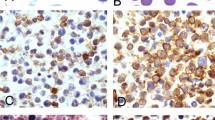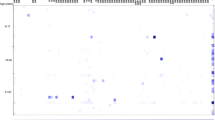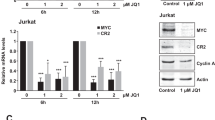Abstract
Human herpesvirus-8 (HHV-8) has been detected in Kaposi's sarcoma (KS) lesions of all types (AIDS-related, classical and endemic), in body-cavity-based B-cell lymphomas (BCBLs) and in le-sions of multicentric Castleman's disease (MCD). We have identified a major gamma-herpesvirus-divergent locus (DL-B) in HHV-8 DNA encoding several HHV-8 unique open reading frames (ORFs), including a homologue of interleukin-6 (IL-6) and two homologues of macrophage inflammatory protein MIP-1. We show that the HHV-8-encoded IL-6 homologue (vlL-6) shares functional properties with endogenous IL-6 proteins and that both vlL-6 and vMIP-1 transcripts are present at high levels following butyrate induction of an HHV-8+ BCBL cell line. Low amounts of constitutive vlL-6, but not vMIP-1, mRNA were also detected. The presence of a functional IL-6 homologue encoded by HHV-8 may provide a mechanistic model for the hypothesized role of HHV-8 in KS, MCD and BCBL that involves the mitogenic effects of vlL-6 on surrounding cells. MIP-1 proteins may enhance these effects through the chemotactic recruitment of endogenous cy-tokine-producing cells into affected tissues and could potentially influence HIV disease progression in coinfected individuals through interactions with the HIV co-receptor CCR-5.
This is a preview of subscription content, access via your institution
Access options
Subscribe to this journal
Receive 12 print issues and online access
$209.00 per year
only $17.42 per issue
Buy this article
- Purchase on Springer Link
- Instant access to full article PDF
Prices may be subject to local taxes which are calculated during checkout
Similar content being viewed by others
References
Chang, Y. et al. Identification of herpesvirus-like DNA sequences in AIDS-associated Kaposi's sarcoma. Science 265, 1865–1869 (1994).
Boshoff, C. et al. Kaposi's sarcoma-associated herpesvirus in HIV-negative Kaposi's sarcoma. Lancet 345, 1043–1044 (1995).
Dupin, N. et al. Herpesvirus-like DNA in patients with Mediterranean Kaposi's sarcoma. Lancet 345, 761–762 (1995).
Moore, P.S. et al. Primary characterization of a herpesvirus agent associated with Kaposi's sarcoma. J. Virol. 70, 549–558 (1996).
Schalling, M., Ekman, M., Kaaya, E.E., Linde, A., & Bieberfeld, P. A role for a new herpesvirus (KSHV) in different forms of Kaposi's sarcoma. Nature Med. 1, 707–708 (1995).
Cesarman, E., Chang, Y., Moore, P.S., Said, J.W. & Knowles, D.M. Kaposi's sarcoma-associated herpesvirus-like DNA sequences are present in AIDS-related body cavity based lymphomas. N. Engl. J. Med. 332, 1186–1189 (1995).
Soulier, J. et al. Kaposi's sarcoma-associated herpesvirus-like DNA sequences in multicentric Castleman's disease. Blood 86, 1276–1280 (1995).
Gompels, G.A. et al. The DNA sequence of human herpesvirus-6: Structure, coding content and genome evolution. Virology 209, 29–51 (1995).
Albrecht, J.-C. et al. Primary structure of the herpesvirus saimiri genome. J. Virol 66, 5047–5058 (1992).
Smith, C.A. A novel viral homologue of Bcl-2 and Ced-9. Trends Cell Biol 5, 344 (1995).
Cheng, E.H.-Y. et al. Kaposi's sarcoma-associated virus, HHV8, encodes a bcl-2 homolog that inhibits apoptosis. Proc. Natl. Acad. Sci. USA 94, 690–694 (1997).
Hirano, T. et al. Complementary DNA for a novel human interleukin (BSF-2) that induces B lymphocytes to produce immunoglobulin. Nature 324, 73–76 (1986).
Yasukawa, K. et al. Structure and expression of human B Cell stimulatory factor-2 (BSF-2/IL-6) gene. EMBO J. 6, 2939–2945 (1987).
Oppenheim, J.J., Zachariae, C.O.C., Mukaida, N. & Matsushima, K. Properties of the novel proinflammatory supergene ‘intercrine” cytokine family. Annu. Rev. Immunol. 9, 617–648 (1991).
Baggiolini, M., Dewald, B. & Moser, B. Interleukin-8 and related chemotactic cytokines-CXC and CC chemokines. Adv. Immunol. 55, 97–179 (1994).
Gerrard, C. & Gerrard, N.P. C5A anaphylatoxin and its seven membrane-segment receptor. Annu. Rev. Immunol. 12, 775–808 (1994).
Cocchi, F. et al. Identification of RANTES, MIP-1 alpha, and MIP-1 beta as the major HIV-suppressive factors produced by CD8+ T Cells. Science 270, 1811–1815 (1995).
Deng, H. et al. Identification of a major co-receptor for primary isolates of HIV-1. Nature 381, 661–666 (1996).
Dragic, T. et al. HIV-1 entry into CD4+ Cells is mediated by the chemokine receptor CC-CKR-5. Nature 381, 667–673 (1996).
Feng, Y., Broder, C.C., Kennedy, P.E. & Berger, E.A. HIV-1 entry cofactor: Functional cDNA cloning of a seven-transmembrane G protein-coupled receptor. Science 272, 872–877 (1996).
Schall, T.J. Bacon, K. Camp, R.D.R. Kaspari, J.W. & Goeddel, D.V. Human macrophage inflammatory protein a (MIP-1α) and MIP-1β chemokines attract distinct populations of lymphocytes. J. Exp. Med. 177, 1821–1826 (1993).
Hibi, M. et al. Molecular cloning and expression of an IL-6 signal transducer, gp130. Cell 63, 1149–1157 (1990).
Taga, T., Kawanishi, K., Hardy, R.R., Hirano, T., & Kishimoto, T. Receptors for B Cell stimulatory factor 2: Quantitation, specificity, distribution, and regulation of their expression. J. Exp. Med. 166, 967–986 (1987).
Akira, S. et al. A nuclear factor for IL-6 expression (NF-IL6) is a member of the C/EBP family. EMBO J. 9, 1897–1906 (1990).
Castell, J.V. et al. Recombinant human interleukin-6 (IL-6/BSF-2/HSF) regulates the synthesis of acute phase proteins in human hepatocytes. FEBS Lett. 232, 347–350 (1988).
Poli, V., & Cortese, R. Interleukin 6 induces a liver-specific nuclear protein that binds to the promoter of acute-phase genes. Proc. Natl. Acad. Sci. USA 86, 8202–8206 (1989).
Cesarman, E. et al. In vitro establishment and characterization of two AIDS-related lymphoma Cell lines containing Kaposi's sarcoma-associated herpesvirus-like (KSHV) DNA sequences. Blood 86, 2708–2714 (1995).
Miller, G. et al. Antibodies to butyrate-inducible antigens of Kaposi's sarcoma-associated herpesvirus in patients with HIV-1 infection. N. Engl. J. Med. 334, 1292–1297 (1996).
Gao, S.-J. et al. KSHV antibodies among Americans, Italians and Ugandans with and without Kaposi's sarcoma. Nature Med. 2, 925–928 (1996).
Kedes, D.H. et al. The seroepidemiology of human herpesvirus 8 (Kaposi's sarcoma-associated herpesvirus): Distribution of infection in KS risk groups and evidence for sexual transmission. Nature Med. 2, 918–924 (1996).
Miles, S. et al. AIDS Kaposi's sarcoma-derived Cells produce and respond to inter-leukin-6. Proc. Natl. Acad. Sci. USA 87, 4068–4072 (1990).
Murakimi-Mori, K., Taga, T., Kishimoto, T., Nakamura, S., AIDS-associated Kaposi's sarcoma (KS) Cells express oncostatin M (OM)-specific receptor but not leukemia inhibitory factor/OM receptor or interleukin-6 receptor. J. Clin. Invest. 96, 1319–1327 (1995).
Sturzl, M. et al. Identification of interleukin-1 and platelet-derived growth factor-B as major mitogens for the spindle Cells of Kaposi's sarcoma: A combined in vitro and in vivo analysis. Oncogene 10, 2007–2016 (1995).
Miles, S.A. et at. Oncostatin M as a potent mitogen for AIDS-Kaposi's sarcoma-derived Cells. Science 255, 1432–1434 (1992).
Nair, B.C. et al. Identification of a major growth factor for AIDS-Kaposi's sarcoma Cells as Oncostatin M. Science 255, 1430–1432 (1992).
Gearing, D.P. et al. The IL-6 signal transducer, gp130: An oncostatin M receptor and affinity converter for the LIF receptor. Science 255, 1434–1437 (1992).
Ishiyama, T. et al. Immunodeficiency and IL-6 production by peripheral blood monocytes in multicentric Castleman's disease. Br. J. Haematol. 86, 483 (1994).
Kawano, M. et al. Autocrine generation and requirement of BSF-2/IL-6 for human multiple myelomas. Nature 332, 83–85 (1988).
Zhang, X.G., Klein, B. & Bataille, R. Interleukin-6 is a potent myeloma-Cell growth factor in patients with aggressive multiple myeloma. Blood 74, 11–13 (1989).
Yamamura, Y. et al. Synthesis of a novel cytokine and its gene (LD78) expressions in hematopoietic fresh tumor Cells and Cell lines. J. Clin. Invest. 84, 1707–1712 (1989).
Schmidtmayerova, H., Sherry, B. & Bukrinsky, M. Chemokines and HIV replication. Nature 382, 767 (1996).
Nicholas, J. et al. A single 13 kilobase divergent locus in the Kapposi's sarcoma associated herpesvirus (HHV-8) genome contains nine open reading frames that are homologous to or related to Cellular proteins. J. Virol. (in the press).
Aarden, L.A., De Groot, E.R., Schapp, O.L. & Landsdorp, P.M. Production of hybridoma growth factor by human monocytes. Eur. J. Immunol. 17, 1411–1416 (1987).
Sambrook, J., Fritsch, E.F. & Maniatis, T. Molecular Cloning: A Laboratory Manual, 2nd edn. (Cold Spring Harbor Laboratory Press, Cold Spring Harbor, New York, 1989).
Devereux, J. Haeberli, P. & Smithies, O.A. A comprehensive set of sequence analysis programs for the VAX. Nucleic Adds Res. 12, 387–395 (1984).
Author information
Authors and Affiliations
Rights and permissions
About this article
Cite this article
Nicholas, J., Ruvolo, V., Burns, W. et al. Kaposi's sarcoma-associated human herpesvirus-8 encodes homologues of macrophage inflammatory protein-1 and interleukin-6. Nat Med 3, 287–292 (1997). https://doi.org/10.1038/nm0397-287
Received:
Accepted:
Issue Date:
DOI: https://doi.org/10.1038/nm0397-287
This article is cited by
-
Castleman disease
Nature Reviews Disease Primers (2021)
-
Kaposi sarcoma
Nature Reviews Disease Primers (2019)
-
Primary lymphocyte infection models for KSHV and its putative tumorigenesis mechanisms in B cell lymphomas
Journal of Microbiology (2017)
-
Targeting the ATP-dependent formation of herpesvirus ribonucleoprotein particle assembly as an antiviral approach
Nature Microbiology (2016)
-
Manipulation of the host cell membrane by human γ-herpesviruses EBV and KSHV for pathogenesis
Virologica Sinica (2016)



